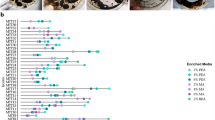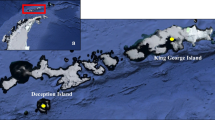Abstract
Ten fungal isolates with an ability to degrade crude oil were isolated from select marine substrates, such as mangrove sediments, Arabian Sea sediments, and tarballs. Out of the ten isolates, six belonged to Aspergillus, two to Fusarium and one each to Penicillium and Acremonium as identified using ITS rDNA sequencing. The selected ten fungal isolates were found to degrade the long-chain n-alkanes as opposed to short-chain n-alkanes from the crude oil. Mangrove fungus #NIOSN-M126 (Penicillium citrinum) was found to be highly efficient in biodegradation of crude oil, reducing the total crude oil content by 77% and the individual n-alkane fraction by an average of 95.37%, indicating it to be a potential candidate for the development into a bioremediation agent.





Similar content being viewed by others
References
Adebusoye SA, Ilori MO, Amund OO, Teniola OD, Olatope SO (2007) Microbial degradation of petroleum hydrocarbons in a polluted tropical stream. World J Microbiol Biotechnol 23:1149–1159
Al-Nasrawi H (2012) Biodegradation of crude oil by fungi isolated from Gulf of Mexico. J Bioremediat Biodegrad 3:147. https://doi.org/10.4172/2155-6199.1000147
Altschul SF, Gish W, Miller W, Myers EW, Lipman DJ (1990) Basic local alignment search tool. J Mol Biol 215:403–410
April TM, Abbott SP, Foght JM, Currah RS (1998) Degradation of hydrocarbons in crude oil by the ascomycete Pseudallescheria boydii (Microascaceae). Can J Microbiol 44:270–278
Bartha R, Atlas RM (1977) The microbiology of aquatic oil spills. Adv App Microbiol 22:225–266
Bento FM, Beech IB, Gaylarde CC, Englert GE, Muller IL (2005) Degradation and corrosive activities of fungi in a diesel–mild steel–aqueous system. World J Microb Biotechnol 21:135–142
Bik HM, Halanych KM, Sharma J, Thomas WK (2012) Dramatic shifts in benthic microbial eukaryote communities following the deepwater horizon oil spill. PLoS One 7:e38550
Chaillan FA, Le Flèche EB, Phantavong YH, Grimont PAS, Oudot J (2004) Identification and biodegradation potential of tropical aerobic hydrocarbon-degrading microorganisms. Res Microbiol 155:587–595
Clemente AR, Anazawa TA, Durrant LR (2001) Biodegradation of polycyclic aromatic hydrocarbons by soil fungi. Braz J Microbiol 32:255–261
Colombo JC, Cabello M, Arambarri AM (1996) Biodegradation of aliphatic and aromatic hydrocarbons by natural soil microflora and pure cultures of imperfect and lignolytic fungi. Environ Pollut 94:355–362
Costello J (1979) Morbidity and mortality study of shale oil workers in the United States. Environ Health Perspect 30:205–208
Defeo O, McLachlan A, Schoeman DS, Schlacher TA, Dugan J, Jones A, Lastra M, Scapini F (2009) Threats to sandy beach ecosystems: a review. Estuar Coast Shelf Sci 81:1–12
Elshafie A, AlKindi AY, Al-Busaidi S, Bakheit C, Albahry SN (2007) Biodegradation of crude oil and n-alkanes by fungi isolated from Oman. Mar Pollut Bull 54:1692–1696
Fathalla EM (2007) Degradation of crude oil in the environment: toxicity arising through photochemical oxidation in the aqueous phase. PhD thesis Munster University, Germany
Fedorak PM, Semple KM, Westlake DWS (1984) Oil-degrading capabilities of yeasts and fungi isolated from coastal marine environments. Can J Microbiol 30:565–571
Fernandes SO, Kirchman DL, Michotey VD, Bonin PC, LokaBharathi PA (2014) Bacterial diversity in relatively pristine and anthropogenically-influenced mangrove ecosystems (Goa, India). Braz J Microb 45:1161–1171
Glass NL, Donaldson GC (1995) Development of primer sets designed for use with the PCR to amplify conserved genes from filamentous ascomycetes. Appl Environ Microbiol 61:1323–1330
Lotfinasabal S, Gunale VR, Rajurkar NS (2012) Assessment of petroleum hydrocarbon degradation from soil and tarball fungi. Biosci Discov 3:186–192
Márquez-Rocha FJ, Olmos-Soto J, Rosano-Hernández MC, Muriel-García M (2005) Determination of the hydrocarbon-degrading metabolic capabilities of tropical bacterial isolates. Int Biodeterior Biodegrad 55:17–23
Mesyami P, Baheri M (2003) Pre-screening of fungi and bulking agents for contaminated soil bioremediation. Adv Environ Res 7:881–887
Mishra S, Jyot J, Kuhad RC, Lal B (2001) In situ bioremediation potential of an oily sludge-degrading bacterial consortium. Curr Microbiol 43:328–335
Novotny C, Erbanova P, Sasek V, Kubatova A, Cajthaml T, Lang E et al (1999) Extracellular oxidative enzyme production and PAH removal in soil by exploratory mycelium of white rot fungi. Biodegradation 10:159–168
Onuoha CI, Arinze AE, Ataga AE (2003) Evaluation of growth of some fungi in crude oil polluted environment. Glob J Agric Sci 2:1596–2903
Owens EH, Taylor E, Humphrey B (2008) The persistence and character of stranded oil on coarse-sediment beaches. Mar Pollut Bull 56:14–26
Plohl K, Leskovsek H, Bricelj M (2002) Biological degradation of motor oil in water. Acta Chim Slov 49:279–289
Prenafeta-Boldú FX, Andrea K, Luykx DM, Heidrun A, Van Groenestijn JW (2001) Isolation and characterisation of fungi growing on volatile aromatic hydrocarbons as their sole carbon and energy source. Mycol Res 105:477–484
Saitou N, Nei M (1987) The neighbor-joining method: a new method for reconstructing phylogenetic trees. Mol Biol Evol 4:406–425
Santos EO, Centeno da Rosa CF, dos Passos CT, Sanzo AVL, de Medeiros Burkert JF, Kalil SJ et al (2008) Pre-screening of filamentous fungi isolated from a contaminated site in Southern Brazil for bioaugmentation purposes. Afr J Biotechnol 7:1314–1317
Sanyal O, Shinde VL, Meena RM, Damare S, Shenoy BD (2016) The ITS-based phylogeny of fungi associated with tarballs. Mar Pollut Bull. https://doi.org/10.1016/j.marpolbul.2016.09.052
Silva DP, Cavalcanti DD, de Melo EV (2015) Bio-removal of diesel oil through a microbial consortium isolated from a polluted environment. Int Biodeterior Biodegrad 97:85–89
Simister RL, Poutasse CM, Thurston AM, Reeve JL, Baker MC, White HK (2015) Degradation of oil by fungi isolated from Gulf of Mexico beaches. Mar Pollut Bull 100:327–333
Singh H (2006) Mycoremediation: fungal bioremediation. Wiley-Interscience, New York, p 592
Tamura K, Nei M, Kumar S (2004) Prospects for inferring very large phylogenies by using the neighbor-joining method. Proc Natl Acad Sci USA 101:11030–11035
Tamura K, Peterson D, Peterson N, Stecher G, Nei M, Kumar S (2011) MEGA5: molecular evolutionary genetics analysis using maximum likelihood, evolutionary distance, and maximum parsimony methods. Mol Biol Evol 28:2731–2739
Thomas SA (2000) Mushrooms: higher macrofungi to clean up the environment. Battelle Environmental Issues, Fall 2000
Toledo FL, Calvo C, Rodelas B, Lopez JG (2006) Selection and identification of bacteria isolated from waste crude oil with polycyclic aromatic hydrocarbons removal capacities. Syst Appl Microbiol 29:244–252
Wang X, Wang X, Liu M et al (2015) Adsorption–synergic biodegradation of diesel oil in synthetic seawater by acclimated strains immobilized on multifunctional materials. Mar Pollut Bull 92:195–200
White TJ, Bruns T, Lee S, Taylor J (1990) Amplification and direct sequencing of fungal ribosomal RNA genes for phylogenetics. In: Innis M, Gelfand D, Sninsky J, White T (eds) PCR protocols: a guide to methods and applications. Academic Press, New York, pp 315–322
Yamada K, Mukumoto H, Katsuyama Y, Tani Y (2002) Degradation of long-chain alkanes by a polyethylene-degrading fungus, Penicillium simplicissimum YK. Enzyme Microb Technol 30:828–831
Acknowledgements
The authors thank the Director of CSIR-National Institute of Oceanography and Head, Biological Oceanography Division for their support and providing all the facilities to carry out this study. We are thankful to Dr. Belle Damodara Shenoy for his valuable suggestions. The authors gratefully acknowledge the funding support received from the project BSC0111 funded by Council of Scientific and Industrial Research (CSIR), India. We are also thankful to the anonymous reviewers whose suggestions and constructive comments helped us to improve the manuscript. This is NIO Contribution number ####.
Author information
Authors and Affiliations
Corresponding author
Ethics declarations
Conflict of interest
The authors declare that they have no conflict of interest.
Electronic supplementary material
Below is the link to the electronic supplementary material.
Rights and permissions
About this article
Cite this article
Barnes, N.M., Khodse, V.B., Lotlikar, N.P. et al. Bioremediation potential of hydrocarbon-utilizing fungi from select marine niches of India. 3 Biotech 8, 21 (2018). https://doi.org/10.1007/s13205-017-1043-8
Received:
Accepted:
Published:
DOI: https://doi.org/10.1007/s13205-017-1043-8




